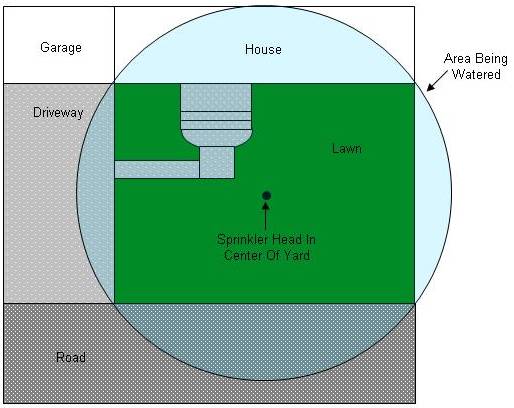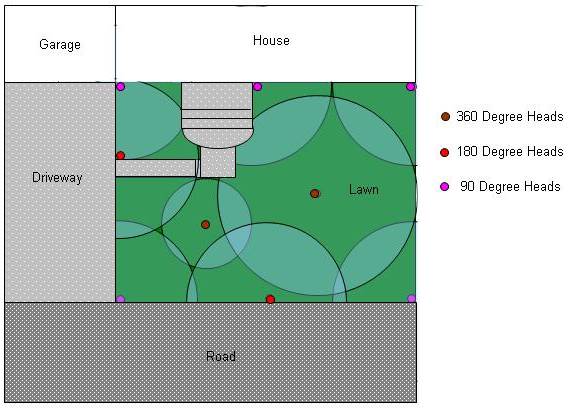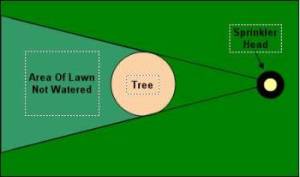The most common method of installation is to place the watering heads at the corners of the property and along perimeter lines. Spacing between pop-up heads depends to a great degree on the manufacturer and the water pressure available. Some pop-up heads can throw water distances of more than 20'.
In general, the more sprinkler heads you install the greater the control you will have over the area being watered. The farther the nozzle is squirting water, the more likely that unnecessary items will be receiving water. This is why placing an impact sprinkler head, that can throw water 40, 50 or 60 feet is generally not an efficient use of water in a residential application, as shown in Figure 15.

Figure 15 - The inefficiency of using a single sprinkler head to water lawn
In our example above, we have a lawn that is 22' deep and 30' wide, a total of 660 sq. ft. In order to reach all four corners we would need to place a sprinkler head that could throw water slightly more than 37', in the center of the lawn. The math would indicate that a sprinkler head that throws water 37', in a circular motion, would cover an area of 1,075 sq. ft. The fact that you only want to water 660 sq. ft. means that less than 60% of the water going through the sprinkler head would actually land on the grass and no consideration was given to the sidewalk or porch.
A proper layout for a sprinkler system, for the lawn in our example, should look similar to Figure 16.

Figure 16 - Proper application and installation of sprinkler heads saves water.
By using the correct application of different sprinkling angles of sprinkler heads, very little water is not delivered to the lawn. The only areas that are not vegetation, that would be watered in this scenario are the sidewalk and part of the porch.
Using additional sprinkler heads on both sides of the sidewalk and porch could prevent watering those areas as well.

Figure 17 - Obstacles in sprinkler head path
Obstacles such as trees, shrub plantings, mail boxes, street lights, telephone poles and landscape lighting must also be taken into account when laying out your sprinkler system design. Any of the aforementioned obstacles will block the spray of water and grass or plantings on the opposite side of the obstacle will not receive any water, as shown in Figure 17.
If you need to run the sprinkler piping under a driveway or sidewalk, you will have to do some horizontal boring.
Additional information on horizontal boring.
You can now purchase landscaping design software which will operate on your home computer, which amongst other features will allow you to create a diagram of your underground sprinkler system layout.
If you don't wish to invest in a software package it is wise to do a to scale drawing of your proposed installation on a piece of graph paper. By laying it out, including major obstacles you will be able to work around location situations before you start digging.
